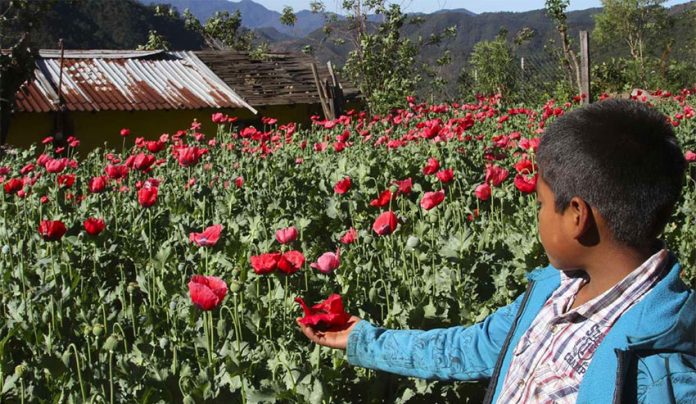The area of land on which opium poppies were cultivated in Mexico between July 2017 and June 2018 declined by 9% compared to the previous year, according to a report published on Thursday.
Completed by the United Nations Office on Drugs and Crime (UNODC) and the Mexican government, the report Mexico Opium Poppy Cultivation Survey 2017-2018 estimates that poppies were grown on 28,000 hectares in the 2017-18 period whereas between July 2016 and June 2017 it was estimated that the plant was grown across 30,600 hectares.
The estimate was based on the interpretation of satellite images that are validated with ground and aerial field verifications, the report said.
It said that the largest concentration of poppy cultivation in the 2017-18 period was located in the mountainous Golden Triangle region of the Sierra Madre Occidental, where the states of Sinaloa, Durango and Chihuahua meet. Large concentrations were also found in the northern part of Nayarit and in the Sierra Madre del Sur of Guerrero.
“Most poppy cultivations are found in remote areas with unpaved roads and trails that are difficult to access,” the UNODC/government report said.
It said that there is “no single explanation” for the 9% decrease in opium poppy cultivation between the 2016- 2017 and 2017-2018 periods but noted that one “important factor to consider in explaining trends in opium poppy cultivation in Mexico is the fluctuation in opium gum prices.”
The Network of Researchers in International Affairs said in a report early last year that Mexican opium gum prices had plummeted by as much as 80% in 2018 due to to the rise in demand for the synthetic opioid fentanyl among United States drug users.
In addition to the reduction in the cultivation of opium poppies, authorities eradicated less of the plant in 2018 than they did the year before.
According to federal government data, 23,625 hectares of poppy fields were eradicated in 2018, a 20% reduction compared to 2017 when 29,692 hectares were cleared.
In turn, seizures of opium gum, poppy seeds and morphine decreased by 56%, 49% and 64%, respectively, but confiscations of heroin went up by 39% from 358 kilograms to 496 kilograms.
The survey completed by the UNODC and the Mexican government was the first to generate estimates for opium gum yields, which was reported at 16.1 kilograms per hectare, and the potential domestic production of dry opium, which was estimated at 450 tonnes.
The report also said that the opium gum produced in Mexico is estimated to have a pure opium content of 16.2%.
The data contained in the report “will allow Mexico to better understand the trends in cultivation and production of opium poppy,” the UNODC and Mexican government said, adding that the information is “fundamental to the planning of comprehensive public policies to reduce supply and mitigate the social consequences of the illicit drug market.”
Source: Reforma (sp)
